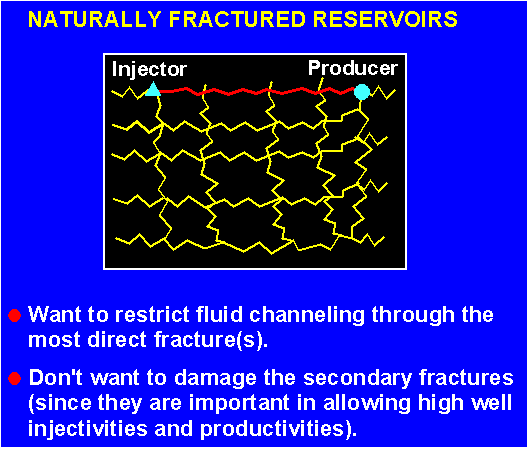Injector-Producer Channelling in Naturally Fractured Reservoirs
Problem 10 in Table 1

Some of the most successful gel treatments were applied to reduce water and gas channeling in naturally fractured reservoirs.11,55-58,68,70 The primary objective of these gel treatments was to improve sweep efficiency and to promote incremental oil production. A secondary benefit of the gel treatments was the substantial reduction of excessive water and gas production at the offsetting production wells. During these injection well applications, the time required to inject large volumes (e.g., 10,000 to 37,000 bbls) of gel was typically greater than the gelation time by a factor around 100.11,57,58 Thus, formed gels extruded through fractures during most of the placement process. Several operators reported that oil recovery increased with increased volume of gel injected per treatment.11,57,58 However, sizing of these treatments to date has been empirical—dictated primarily by perceived economic and operational limitations. Engineering-based sizing methods are under development for this type of problem.63
Theoretical work indicates that gel treatments have the greatest potential when the conductivities of fractures that are aligned with direct flow between an injector-producer pair are at least 10 times the conductivity of off-trend fractures.63 Gel treatments also have their greatest potential in reservoirs with moderate to large fracture spacing. Produced tracer concentrations from interwell tracer studies can help identify reservoirs that are good candidates for water shutoff using gel treatments. The average width of the most direct fracture between an injector-producer pair can be estimated from the breakthrough time from an interwell tracer study using Eq. 4. Since the ability of a gel to extrude through a fracture depends critically on the fracture width or conductivity,39,67,69 this knowledge is important when selecting an appropriate gel formulation for the treatment.
Simulation studies indicate that the potential for successful application of a gel treatment becomes greater as the peak produced tracer concentration increases above 20% of the concentration the injected tracer concentration.63 When produced tracer concentrations are low (i.e., less than 1% of the injected tracer concentration), gel treatments are unlikely to be effective. However, results from a poorly designed tracer test can mislead one to believe that a gel treatment has little potential. For example, if the tracer bank is too small, dispersion can reduce produced tracer concentrations to very low values in a fracture system even though a gel treatment has excellent potential.
Ref. 55 discusses a field example where tracer testing was conducted in conjunction with the application of injection-well CC/AP gel treatments to the Tensleep sandstone formation of the Pitchfork Field in Wyoming.
Gel treatments to reduce injector-producer channeling in naturally fractured reservoirs can be applied in either injection or production wells. Well-documented field applications involving injector-producer channeling in naturally fractured reservoirs can be found in Refs. 11, 55, 57, 58, and 70.